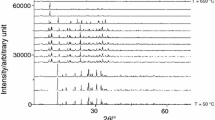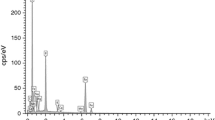Summary
A combination of thermogravimetry and hot stage Raman spectroscopy has been used to study the thermal decomposition of the synthesised zinc substituted takovite Zn6Al2CO3(OH)16·4H2O. Thermogravimetry reveals seven mass loss steps at 52, 135, 174, 237, 265, 590 and ~780°C. MS shows that the first two mass loss steps are due to dehydration, the next two to dehydroxylation and the mass loss step at 265°C to combined dehydroxylation and decarbonation. The two higher mass loss steps are attributed to decarbonation. Raman spectra of the hydroxyl stretching region over the 25 to 200°C temperature range, enable identification of bands attributed to water stretching vibrations, MOH stretching modes and strongly hydrogen bonded CO3 2--water bands. CO3 2- symmetric stretching modes are observed at 1077 and 1060 cm-1. One possible model is that the band at 1077 cm-1is ascribed to the CO3 2- units bonded to one OH unit and the band at 1092 cm-1is due to the CO3 2- units bonded to two OH units from the Zn-takovite surface. Thermogravimetric analysis when combined with hot stage Raman spectroscopy forms a very powerful technique for the study of the thermal decomposition of minerals such as hydrotalcites.</o:p>
Similar content being viewed by others
Author information
Authors and Affiliations
Rights and permissions
About this article
Cite this article
Frost, R., Martens, W. & Erickson, K. Thermal decomposition of the hydrotalcite. J Therm Anal Calorim 82, 603–608 (2005). https://doi.org/10.1007/s10973-005-0940-y
Issue Date:
DOI: https://doi.org/10.1007/s10973-005-0940-y




